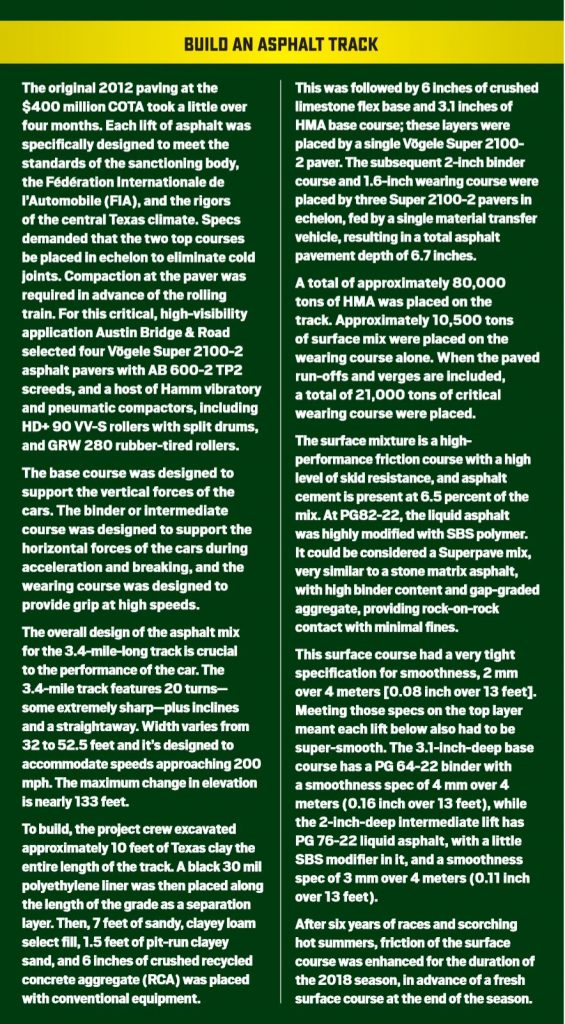Micro Milling Provides Formula 1 Retexture
BY Tom Kuennen
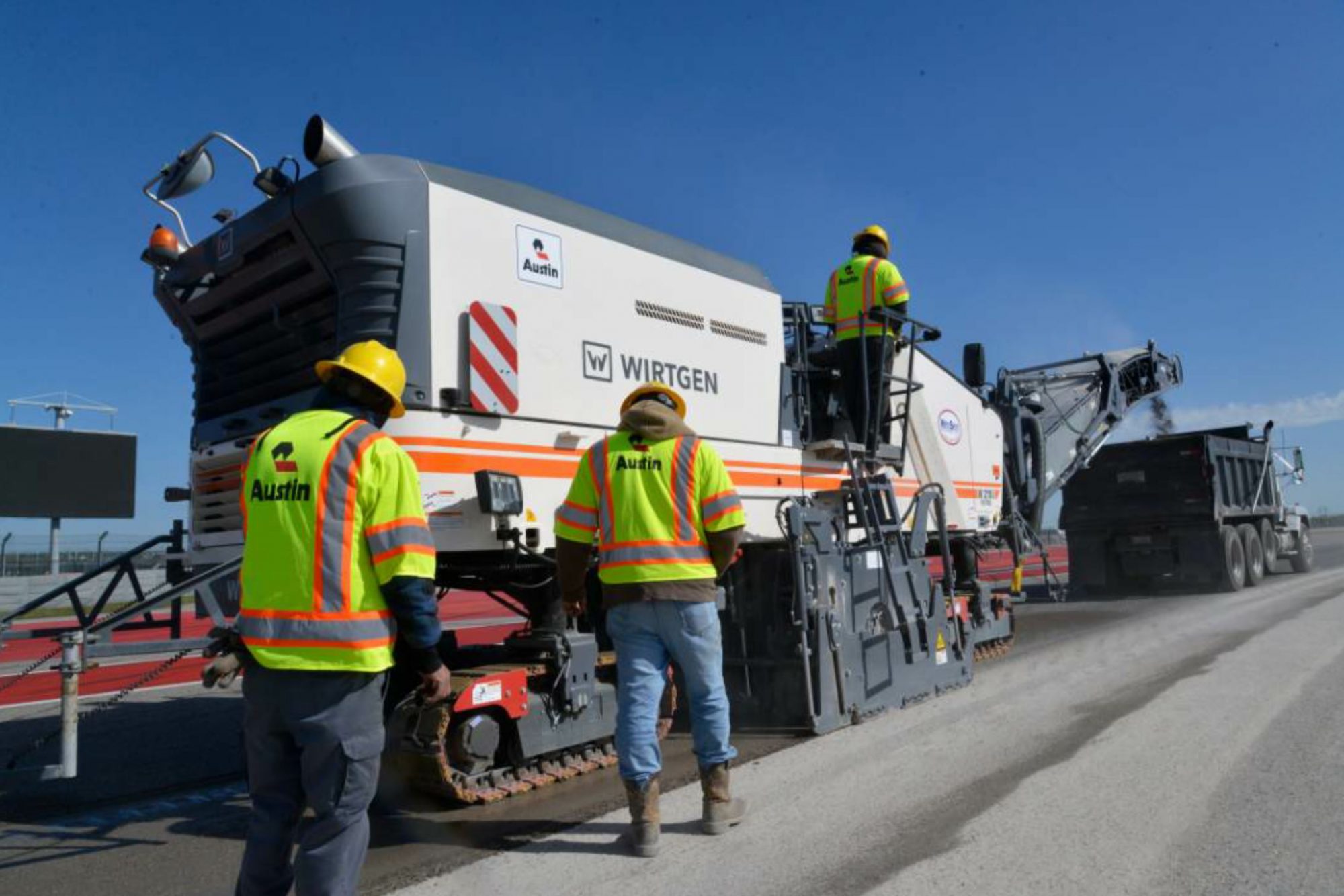
A milling drum configuration unique to Wirtgen—along with the company’s Level Pro system—enabled micro milling and enhanced friction on the Formula 1 Circuit of the Americas (COTA) race track south of Austin, Texas. Austin Bridge & Road, headquartered in Austin, used Wirtgen Group equipment to construct the high-performance track in 2012, and again used specialized Wirtgen products April 2018 to refresh the driving surface that had been affected by the expansive clays Texas can boast. The crew started with diamond grinding and switched over to micro milling.
“After six years, with movement from underneath, plus wear and tear from the racing tires, traction became an issue,” said Tom Chastain, milling application specialist, Wirtgen America. “The owner wanted to return traction to the track, so they first tried diamond-grinding it, but the racers didn’t care for the excessive smoothness. As the owners wanted a different texture on the track, they got us out here with the micro drum.”
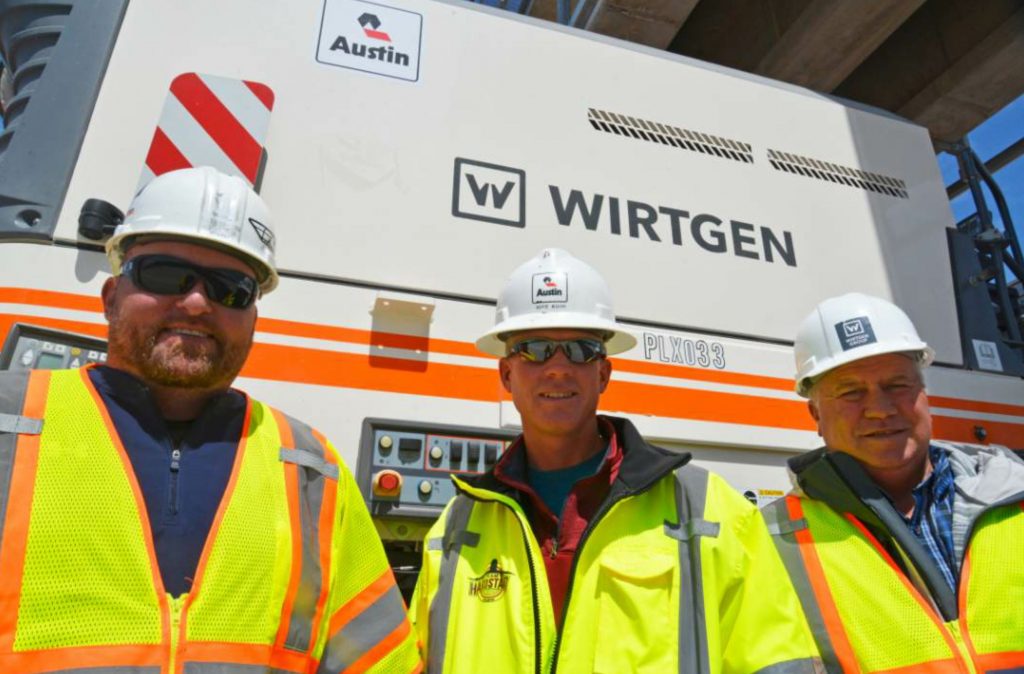
On Circuit of the Americas track are Tom Chastain, milling application specialist for Wirtgen America, Mike Kuhn, general superintendent of Austin Bridge & Road Inc., and Cliff McCarty, district sales manager for Wirtgen.
The driving surface was plagued by both undulations (bumps) and a loss of traction, said Wirtgen district sales manager Clifford McCarty. “It was a little of both,” he said. “As time went on, the track settled, so in some spots we had dips and swirls.” They merely needed to correct the surface for two final races, and then the owner would resurface the track in late December 2018.
“The owner wanted to restore texture in the surface, and remove ‘bumps’ as best we can,” said Mike Kuhn, general superintendent, Austin Bridge & Road. “There were some situations where the bumps were too high compared to the depth of the wearing course, so we had to make adjustments so we didn’t take too much structure out of it. Our goal is to leave at least one inch of surface course.”
“With a race track, you have to anticipate corrections like this,” Chastain said. “The wear and the tear on the track takes a toll, and the ground movement makes it worse. With any race track you will see some sort of corrective maintenance necessary, just to keep it going, before coming back to resurface.”
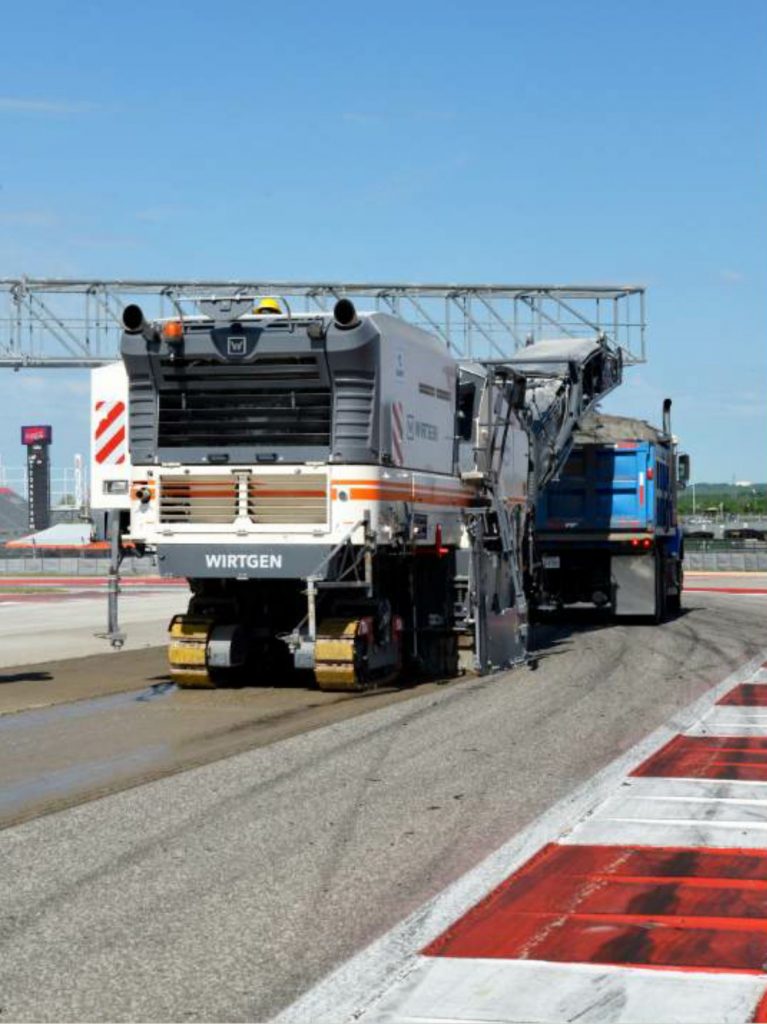
Due to the shallow depth of milling, only 650 tons of material were estimated to be removed. Only two trucks were cycling in and out of the job. All photos courtesy Wirtgen Group.
Drum Tailored for Micro Milling
Micro milling was performed using an LA 6 X 2 drum, that is, 6 millimeter bit spacing with a “double strike” behind. The 7-foot, 2-inch-wide double-strike drum has teeth placed 180 degrees apart on each side of the drum.
“With a standard drum, you have one impact per revolution of the drum per tooth, but on the micro milling drum we have two teeth hitting the same line spacing 180 degrees apart,” Chastain said.
It’s fitted with 748 cutting tools rather than the 168 that a standard milling drum has. The 6-mm tool spacing of these super-fine “micro” milling drums enables them to produce a very finely textured road surface with a maximum milling depth of 1.2 inches (3 centimeters).
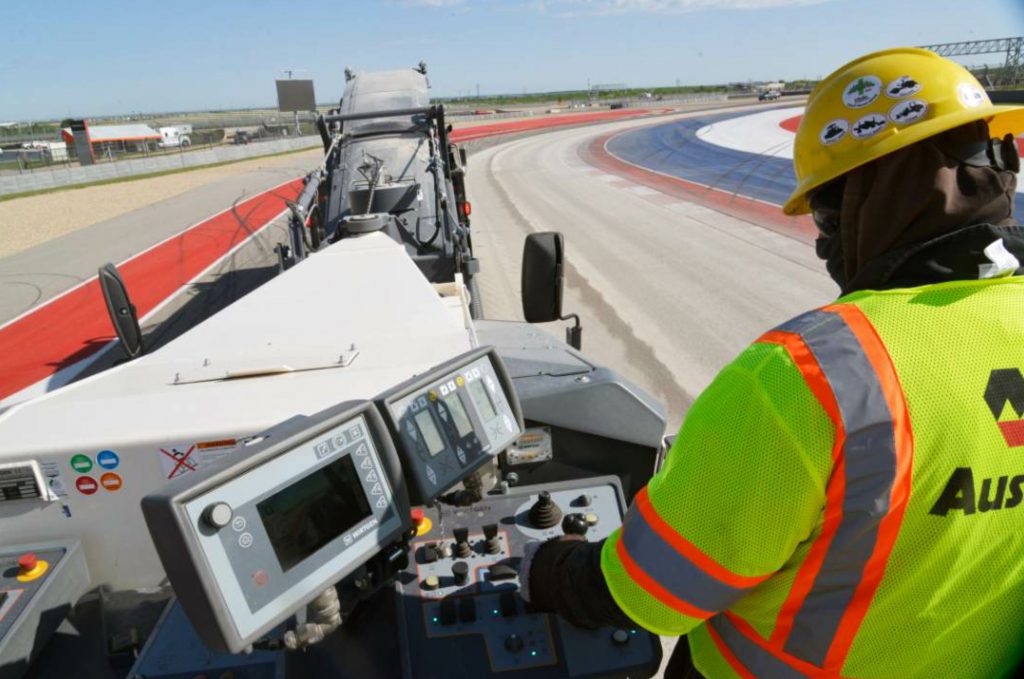
The operator dials in the precise milling depth at the console. “The track has only 1.5 inches of…special mix that Formula 1 specified for its friction courses, so we have only an inch and a half to work with, and we are being careful not to get in between those two layers.”
Moreover, Wirtgen’s FCS Light Flexible Cutter System allows Austin Bridge & Road’s W 210i the flexibility to swap out the micro milling drum for a conventional drum. The milling drums on these cold milling machines can be accessed from the side and are simple to remove, according to the manufacturer; they’re lowered onto a specialized, wheeled drum skid for easy withdrawal from the cutter housing, and the replacement is installed just as easily. With FCS, a drum change takes Austin Bridge & Road no more than two hours, transforming a conventional cold mill to a super-fine micro mill, or back again.
At COTA, cutting depth ranged from 1/8 to 1/2 inch. “The track has only 1.5 inches of surface mix on it,” Chastain said. “It’s a special mix that Formula 1 specified for its friction courses, so we have only an inch and a half to work with, and we are being careful not to get in between those two layers.”
The contractor achieved at least three times the performance per day that had been written into the contract.
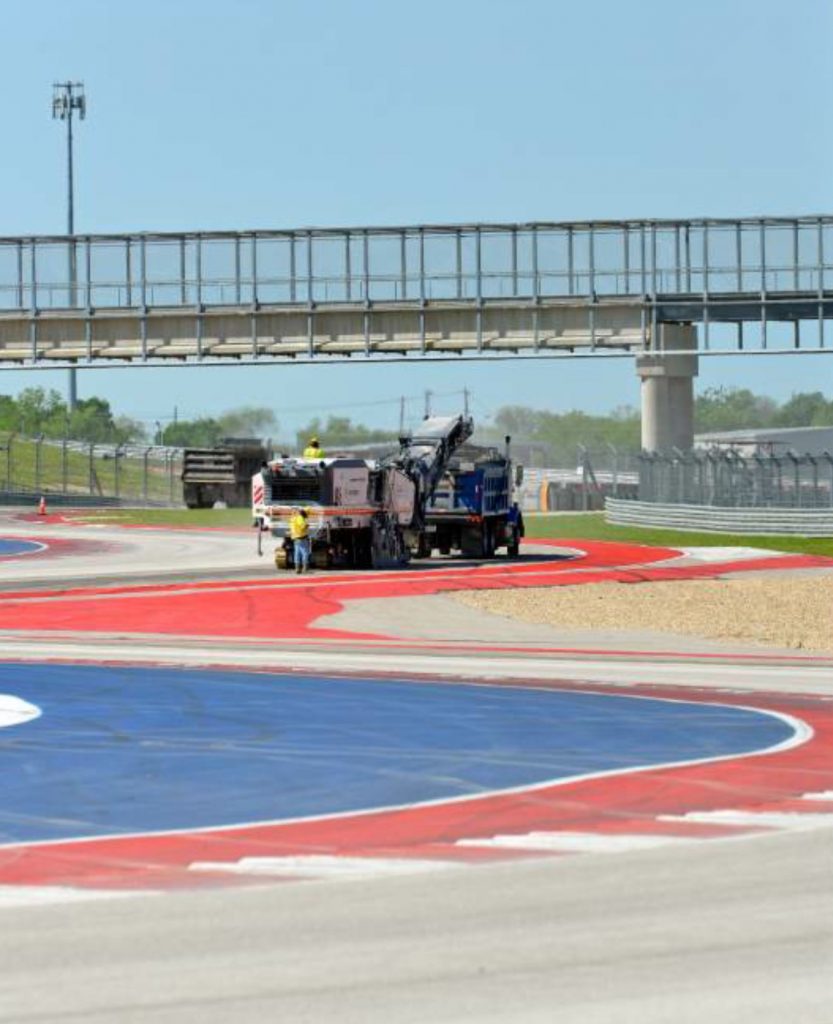
After six years of races and scorching hot summers, friction of the surface course was enhanced for the duration of the 2018 season, in advance of a fresh surface course at the end of the season.
“On Day 1 we did 14,000 square yards,” Chastain said. “The next day we did 12,000 square yards. I think we are well above what the anticipated square yardage was going to be on a daily output.”
The track is 50 feet across, and where necessary, milling took place from outside edge to outside edge. Despite its specialized mission, for micro milling at COTA, standard W6 Wirtgen cutting tools were used. Several days into the project, the mill had cut 27,000 square yards, but had yet to change a tooth.
The complete area of the project was 45,000 square yards, but due to the shallow depth of milling, only 650 tons of material were estimated to be removed. Only two trucks were cycling in and out of the job. “One or the other is sitting most of the time,” Kuhn said. “We’re only dumping six to eight loads a day. We’re not talking about volume, but precision.”
Leveling System Makes it Easy
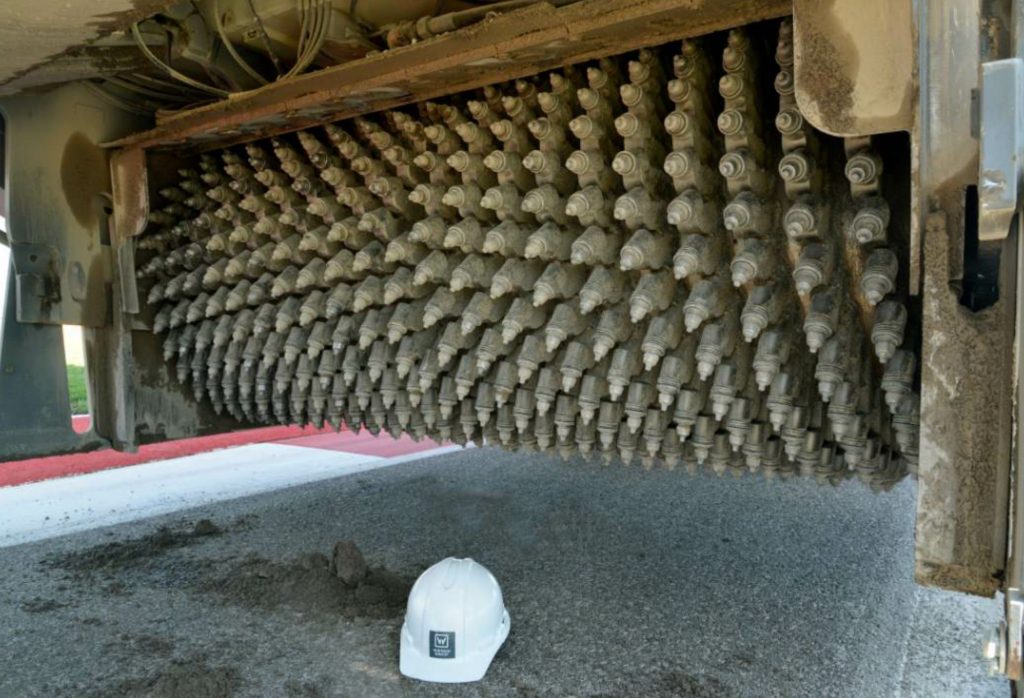
Micro milling was performed using an LA 6 X 2 drum, that is, 6 millimeter bit spacing with a “double strike” behind. The 7-foot, 2-inch-wide double-strike drum has teeth placed 180 degrees apart on each side of the drum.
Austin Bridge & Road’s new W 210i is served by two leveling systems, an outboard multiplex system that uses multiple sensors at the four corners of the cold mill, and the Wirtgen Level Pro system integral with the cutter housing. The COTA micro milling started off using the multiplex system, which was cutting too deeply, and switched over to the Level Pro automatic leveling system exclusively.
“The multiplex system was correcting too much and we were getting too far into the asphalt,” McCarty said.
“We were smoothing out the bumps too much with the multiplex, and cutting as much as an inch down. We didn’t want to go down an inch and then have only a half-inch remaining in the driving course.”
Level Pro works off vertical milling depth cable sensors mounted at each cutter housing side plate, left and right. It also works off sensors in the two “smart” hydraulic lifting cylinders at the side plates. An ultrasonic sensor, which functions without making contact, can scan both the height of the side plate and the reference surface next to or in front of the drum. A slope sensor permanently mounted to the machine is used for creation of surfaces where relative references can’t be used.
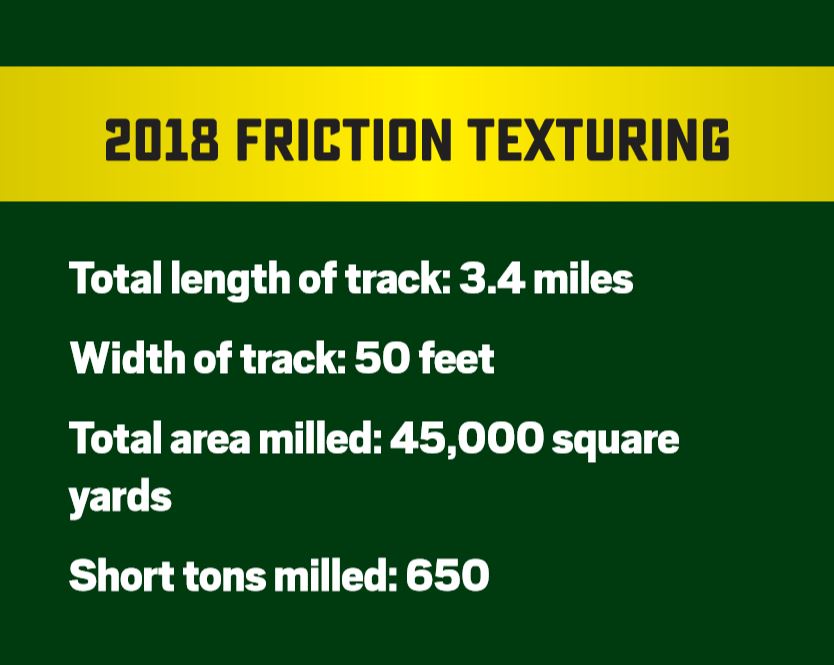
Level Pro’s integration with Wirtgen’s Parallel-to-Surface (PTS) technology allowed the automatic system to initiate the milling process at the maximum depth right from the start. The operator activates the Level Pro system at the flick of a switch, and all four crawler track units of the large milling machine are lowered. When the milling drum assembly reaches the surface, the lowering speed is reduced, and the milling drum slowly penetrates the material down to the set depth. The automatic process contributes to preventing excessive cutting tool wear or even failure when starting to mill.
“We set the depth at an eighth of an inch, and if it needs to get deeper, the automation corrects it to a quarter-inch or half-inch,” McCarty said. “We’re not doing any corrective slope; just doing an eighth-inch on each side.”
Once micro milling had textured the pavement, the mill would return to areas with elongated bumps to remove those using the multiplex system. “After we make the initial pass over the entire track with micro milling, we’ll come back in running multiplex to take the bumps out as best we can,” Chastain said. “Even if we don’t take the entire bump out, we try to smooth it out and dull the crest to give the driver a smoother ride.”
